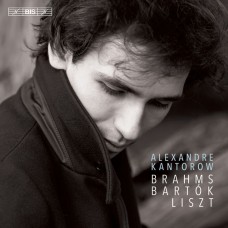您的購物車沒有添加專輯!
搜尋
布拉姆斯/巴爾托克/李斯特鋼琴作品 亞歷山大.康特洛夫 鋼琴 Alexandre Kantorow plays Brahms, Bartok & Liszt
專輯編號: BISSACD2380
專輯類型: SACD
發行年份: 2020
國際條碼: 7318599923802
音樂家:
庫存狀態: 有庫存
|
布拉姆斯:第一號狂想曲/巴爾托克:狂想曲,作品1/李斯特:匈牙利狂想曲第11號
在2019年, 22歲的亞歷山大.康特洛夫成為第一位贏得聲望很高的柴可夫斯基大賽鋼琴組的冠軍. 但在更早之前他已經發行過三張廣受好評的專輯, 獲得法國年度金音叉獎和英國留聲機主編推薦等殊榮, 得到從'轉世的李斯特'到'有如會噴火的名演奏家, 具有詩意般的魅力和天生的大師風格'的評語. 這張獨奏專輯是他贏得柴可夫斯基大賽冠軍之後的第一張發行, 表現出充分發揮演奏名家詩意和魅力的空間, 永遠經過一種敏銳自我風格意識的篩選. 這份節目是圍繞著三首狂想曲而建構, 一種即興式特性的曲目類別, 完美的對應到浪漫主義精神, 但在此被三種高度差異的藝術性格所詮釋: 李斯特, 布拉姆斯和巴爾托克.
此片開頭是成熟的布拉姆斯作品的一個範例, 他寫於1879年的第一號狂想曲, 然後康特洛夫以年輕激情的第二號鋼琴奏鳴曲帶領我們回到這位作曲家職業生涯的初期, 布拉姆斯在21歲時寫下此奏鳴曲 – 只比巴爾托克在1904年時寫下他的狂想曲時小兩歲. 在那時候, 巴爾托克正開始探索成為他非常重要靈感來源的民俗音樂. 身為一個匈牙利人和一位嶄露頭角的鋼琴家, 他非常熟悉李斯特的音樂並且知道匈牙利狂想曲第11號, 這專輯以此曲結尾的最急板(prestissimo)畫下句點.
In 2019, at the age of 22, Alexandre Kantorow became the first French pianist to win the prestigious Tchaikovsky Competition. But already before then he had released three acclaimed discs, awarded distinctions such as Diapason d'orde l'Annee and Gramophone's Editor's Choiceand earning Kantorow descriptions ranging from 'Liszt reincarnated' to 'a firebreathing virtuoso with a poetic charm and innate stylistic mastery'. The present recital, his first release since the Tchaikovsky Competition, offers plenty of scope for virtuosity, poetry and charm, always filtered through an acute stylistic consciousness. The programme is constructed around three rhapsodies, a genre whose improvisatory character corresponds perfectly with the spirit of Romanticism but here interpreted by three highly distinct artistic temperaments: Franz Liszt, Johannes Brahms and Bela Bartok.
Opening with an example of the mature Brahms, his First Rhapsody from 1879, Kantorow takes us back to the very beginning of the composer's career, with the youthfully impassioned Piano Sonata No. 2. Brahms was 21 when he wrote the sonata –only two years younger than Bartok in 1904, the year his Rhapsody was composed. At the time, Bartok was just beginning to discover the folk music which would become such an important source of inspiration. Being a Hungarian and a budding pianist, he was, however, very familiar with the music of Liszt, and will have known the composer's Hungarian Rhapsody No. 11 with its final prestissimo rushing the disc to an impetuous close.
|
編號 |
曲目 |
長度 |
作詞 |
作曲 |
演奏 |
樂團 |
演唱 |
指揮 |
試聽 |
|---|



